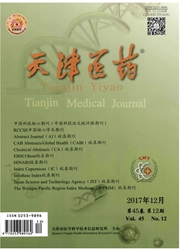

 中文摘要:
中文摘要:
目的探究间歇低氧(IH)条件下引起小鼠血管内皮功能障碍的机制。方法呼吸仿真系统构建IH暴露模型,将60只C57BL/6J雄性小鼠随机分为对照组和IH组。IH组每天低氧暴露8h,持续6周。应用酶联免疫吸附法(ELISA)测定小鼠血清低氧诱导因子-1a(HIF-1a)和基质细胞衍生因子-1a(SDF-1a)的水平;测定2组小鼠血清中活性氧簇(ROS)的水平;运用实时荧光定量PCR检测2组小鼠血清中miR-199a-5p的表达量;应用双荧光素酶报告系统及点突变试验对HIF-1a进行靶基因验证。结果与对照组相比,IH组小鼠HIF-1a(μg/L:1.60±0.02vs.1.19±0.02)、SDF-1a(ng/L:1823.00±8.97vs.1444.00±17.90)的水平明显升高(P<0.01);ROS水平明显高于对照组(U/mL:487.66±35.73vs.211.57±23.82,P<0.01);IH组的血清miR-199a-5p水平低于对照组(1.31±0.07vs.3.47±0.17,P<0.01);双荧光素酶报告基因检测结果证实HIF-1a为miR-199a-5p的靶基因。结论IH可引起小鼠血清miR-199a-5p水平的下降,其靶基因HIF-1a继而升高,而HIF-1a可引起SDF-1a升高,SDF-1a的受体——细胞膜半胱氨酸-X-半胱氨酸受体-4(CXCR4)随之增加,最终引起血清ROS水平升高,导致血管内皮功能障碍。
 英文摘要:
英文摘要:
Objective To explore the mechanism of vessel endothelial dysfunction in rats under intermittent hypoxia(IH).Methods The respiratory simulation system was used to simulate IH.Sixty C57BL/6J rats(male)were randomizedinto control group and IH group.The rats of IH group were exposed to IH8hours per day for6weeks.The serum levels ofhypoxia inducible factor(HIF)-1a and stromal cell derived factor(SDF)-1a were assessed by ELISA.The serum levels ofreactive oxygen species(ROS)were detected in two groups.The serum expression of miR-199a-5p was detected by realtimefluorescent quantitative PCR in two groups.The dual luciferase report system and point mutation test were used to verifytarget gene for HIF-1a.Results The serum levels of HIF-1a and SDF-1a were significantly higher in IH group thanthose of control group(μg/L:1.60±0.02vs.1.19±0.02,1823.00±8.97vs.1444.00±17.90,P<0.01).The serum level of ROSwas significantly higher in IH group than that of control group(U/mL:487.66±35.73vs.211.57±23.82,P<0.01).The serumlevel of miR-199a-5p expression was significantly lower in IH group compared to that of control group(1.31±0.07vs.3.47±0.17,P<0.01).The result of dual luciferase reporter gene detection confirmed that target gene of miR-199a-5p was HIF-1a.Conclusion The serum level of miR-199a-5p is decreased first due to IH,and then its target gene(HIF-1a)isincreased.HIF-1a can induce the increased level of SDF-1a,and its receptor(CXCR-4)is also increased.Finally,HIF-1a can increase the serum level of ROS,resulting in the endothelial dysfunction.
 同期刊论文项目
同期刊论文项目
 同项目期刊论文
同项目期刊论文
 期刊信息
期刊信息
